Who killed Alberto Nisman?
- Published
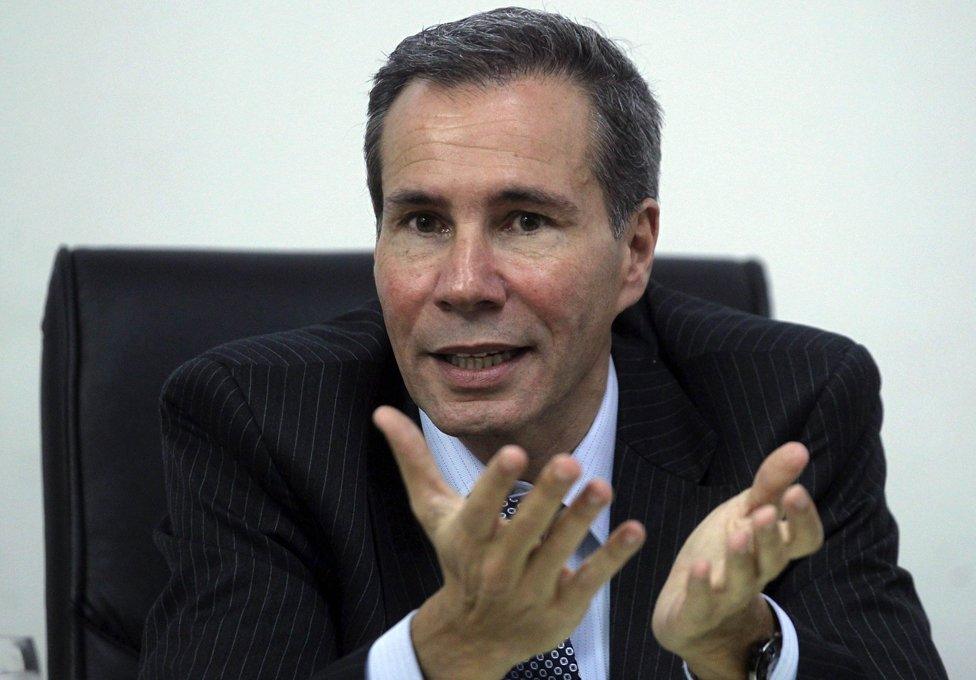
Photo: Reuters
In January a high-profile prosecutor was found in a pool of blood in his bathroom, days before he was due to release a report condemning the Argentine government. Wyre Davies examines claims that he was murdered and that the investigation into his death was bungled.
Buenos Aires may be fading at the edges but it is still one of the world's great capitals - witness to some of the most tragic and momentous events in Argentine history. It is a city where military generals have justified coups d'etats, where grandmothers have marched in defiance against tyranny and where populist icons have vainly tried to unite a divided nation. Even today, intrigue and political scandal are never too far below the surface.
At the start of this year, a critical period in which Argentina's embattled President would be trying to steer the country and its battered economy through to elections in October, an event occurred that rocked the institutions of state to their very core.
At a luxury apartment complex in Buenos Aires' modernised port area, a 51-year-old special prosecutor called Alberto Nisman was preparing to deliver a damning report. He was accusing the Argentine government of being involved in covering up the worst terror attack in the country's history.
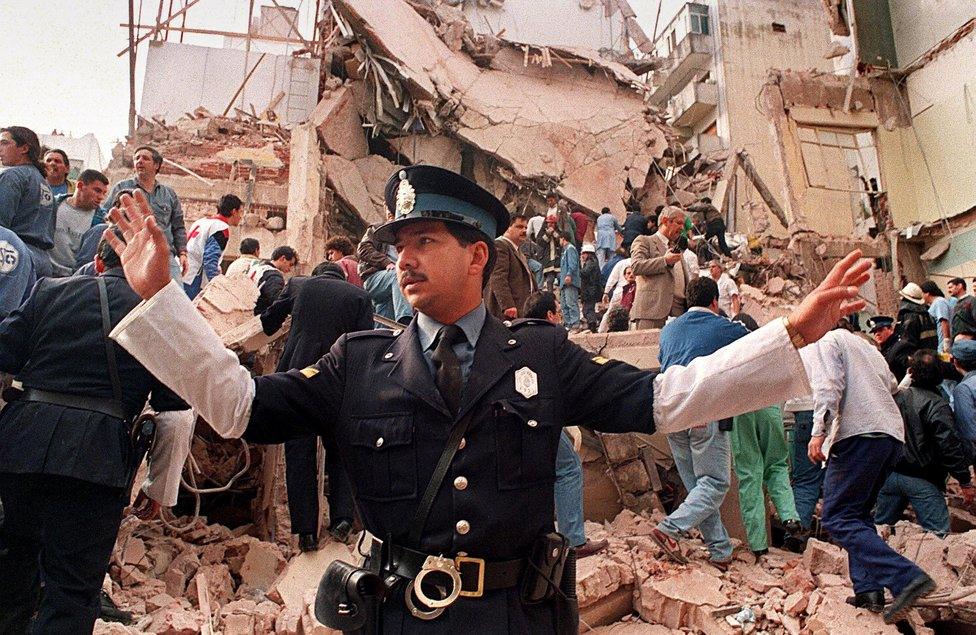
The aftermath of the bomb at the Amia Jewish community centre, 1994. Photo: AFP
Just hours before he was due to present that report to Congress, Nisman was found dead in his 13th floor flat, with a single gunshot wound to the head. Was it suicide or murder?
If it was indeed murder, who may have wanted him dead? To search for the answer you have to first go back to events that happened almost 21 years ago.
On 18 July 1994 a huge bomb destroyed a Jewish community centre in Buenos Aires, the Amia. Eighty-five people were killed as the building collapsed. Much of the evidence was subsequently lost or contaminated, either deliberately or through incompetence, and no-one has ever been convicted in connection with the bombing.
The attack tore the heart out of the city's Jewish community, which with some 400,000 people, is one of the largest outside Israel. The building has been rebuilt with airport style security and huge walls protecting it from any new threat.
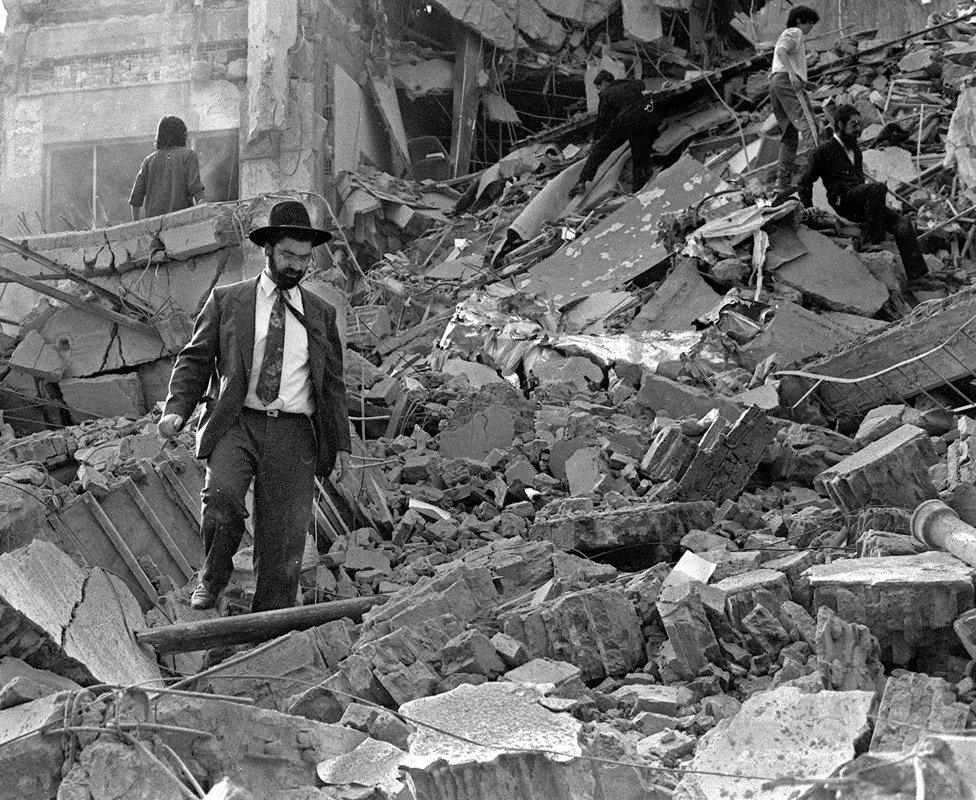
Photo: AFP
The highly regarded and sometimes obsessive prosecutor, Alberto Nisman, had been investigating the Amia bombing for more than a decade, trying to crack the case that no one else could solve.
But in recent months Nisman had begun to make enemies in high places. Alleging there was an attempt to cover up Iran's alleged role in the bombing, on 14 January he filed a criminal complaint against Argentina's President and the Foreign Minister.
The prosecutor trusted few people and often worked from his flat. It was there on 18 January this year that he was found dead.
Lying in his bathroom in a pool of blood and with a handgun next to his body, many well-connected people in Argentina immediately assumed Nisman had killed himself. Even President Fernandez de Kirchner pondered, on her Facebook page, external, what may have made him take his own life.
But one person who rejected this idea from the start was Sandra Arroyo Salgado, Nisman's former partner, his companion of 17 years and mother of his two daughters.
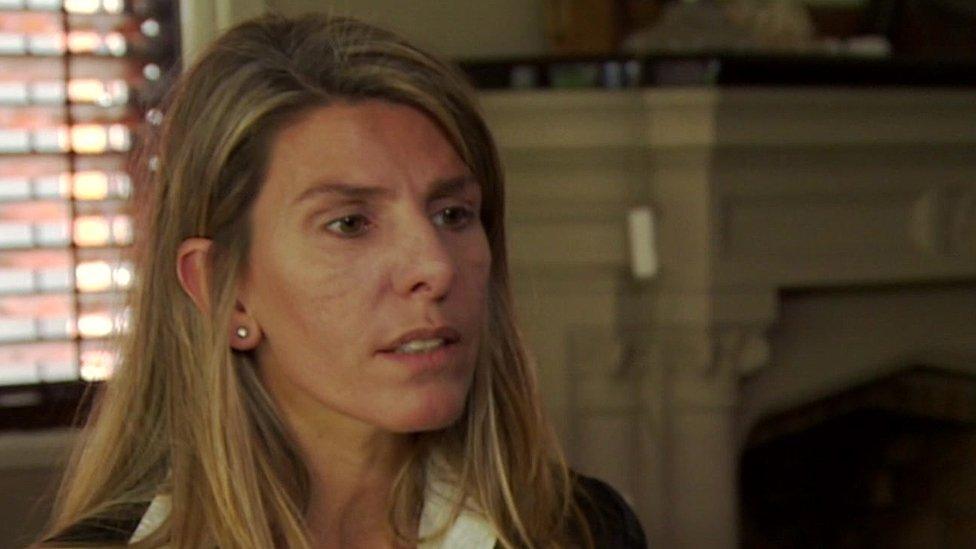
Alberto Nisman's former partner, Sandra Arroyo Salgado
"I have no doubt, that because of the way he was, his personality, he never would have taken his own life," she told me in an exclusive interview at the former family home in a comfortable suburb just outside the city.
"He was extremely careful about his health and was afraid of dying young. So the very moment they told me that he had been found dead and that there was a gun at the scene, I knew that someone had killed him."
At the time of Nisman's death, Sandra Arroyo Salgado was travelling abroad and, on returning to Argentina, she was appalled by the rapid speed of the post-mortem examination and the failure to preserve evidence at the scene. So, although she and Nisman had been separated for some time, Arroyo Salgado - a judge herself - began her own inquiries.
"The only thing we are looking for is the truth," she says. "My investigative team has analysed the photographs and videotape from the official autopsy and they came to the conclusion that Alberto's violent death was certainly not accidental."
She added, "It's as if the investigating authorities were completely ignoring the fact that Alberto was discovered dead just four days after having accused the president of the country of nothing less serious than a possible cover-up of a terrorist attack that killed 85 people."
Dozens of official images were taken at the scene of Nisman's death. They point to a shocking lapse of protocol and procedure. Some pictures show several people walking through the apartment, without protective clothing. Evidence was improperly handled. For example, at one stage police allowed Nisman's mother to wash dishes that had been left dirty in the sink and could, quite possibly, have yielded clues that would help determine if there had been anyone else in the flat.
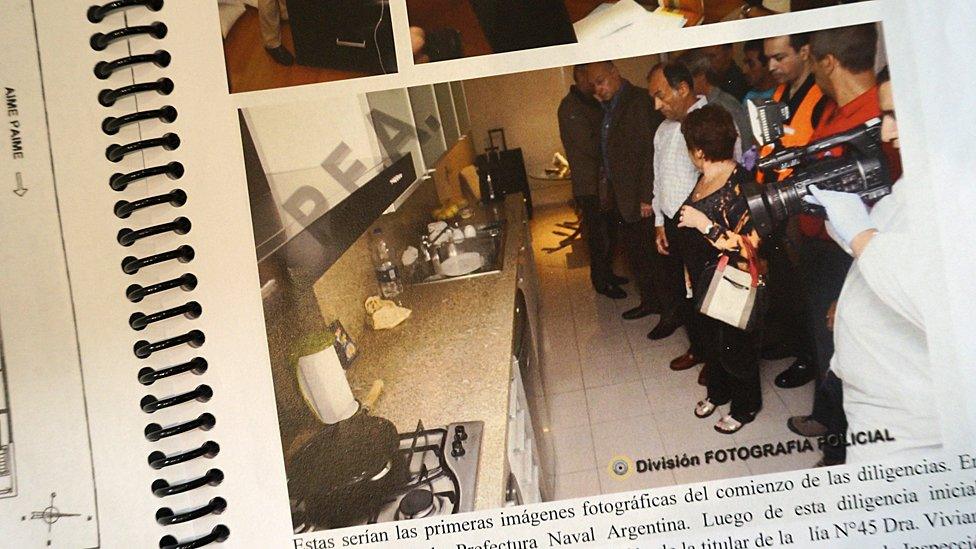
Arroyo Salgado's team also alleges that fingerprints weren't taken from key pieces of evidence like a computer which, she says, investigators powered up without due caution. The gun found at the scene also appears, at some point, to have been picked up, handled and put down elsewhere, again without proper procedure.
Crucially, it was only at the insistence of Arroyo Salgado's team that a Luminol test was carried out several weeks after Nisman's death. It showed that, at some point, there'd been an attempt to wash blood from something in the bathroom sink.
But the woman now in charge of the official investigation into Nisman's death, veteran prosecutor Viviana Fein, denies that her officials botched those initial hours at the scene.
"It's common in Argentina that we don't always put on those white antiseptic robes," Fein told me. "I've been to many homicides and not worn the kind of clothing that the crime specialists use because we don't touch the scene. There was no blood anywhere other than the bathroom, the place where Nisman died."
A very public feud between two of Argentina's highest profile female legal figures has captivated the country. It is believed that Fein's official investigation will probably rule that Nisman killed himself but Arroyo Salgado's investigators say the evidence suggests quite the opposite.
One puzzle is the gunshot wound.
Most suicide victims who shoot themselves do so to the side or the front of the head. The bullet that killed Nisman entered above and behind his right ear - not impossible, but say specialists, a very unlikely scenario.
More doubts are raised by the position of the gun. Official police photographs of Nisman after his death show the contorted body lying in a pool of blood in his bathroom, with the gun underneath his left shoulder, even though he was shot in the right side of the head.
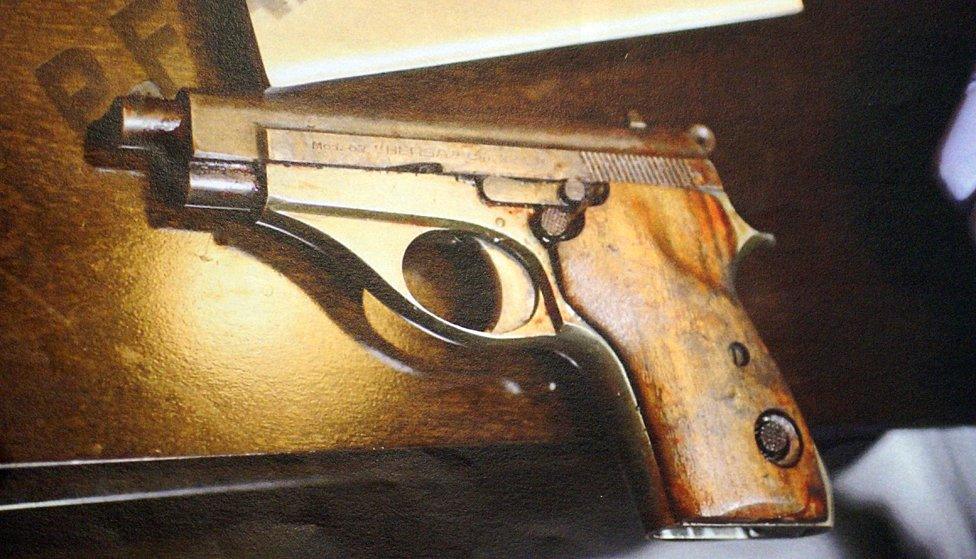
The gun that killed Nisman, Division Fotografia Policial
"One possibility, if he'd shot himself, would have been for the gun to have fallen, or been thrown to the side," says Ignacio Prieto, one of Argentina's leading crime reporters. "But it is hard to imagine how the gun could have made such a 180 degree trajectory, it is very strange."
In Prieto's view, this points towards the involvement of others in the prosecutor's death - a theory, he says, supported by criminologists from Interpol.
"So what the specialists say is that the scene was arranged, they put the body in a certain way, they put the gun in place, they even used a towel to arrange the body."
Prieto concludes, "If you weigh up the evidence for suicide and assassination - the balance of what you see in the photos and in the findings of the investigators, it points more towards murder."
Tests have also failed to find gunshot residue on Nisman's hand.
The weapon that killed Nisman, was a rather old .22 calibre Bersa handgun. It belonged to a 38-year-old computer specialist, Diego Lagomarsino, who worked closely with the prosecutor.
In a chaotic press conference after the body was found, Lagomarsino denied being part of a conspiracy to kill his boss. Later, he told me his version of events - that Nisman asked to borrow the gun because he could no longer trust his police bodyguards and wanted to protect his daughters.
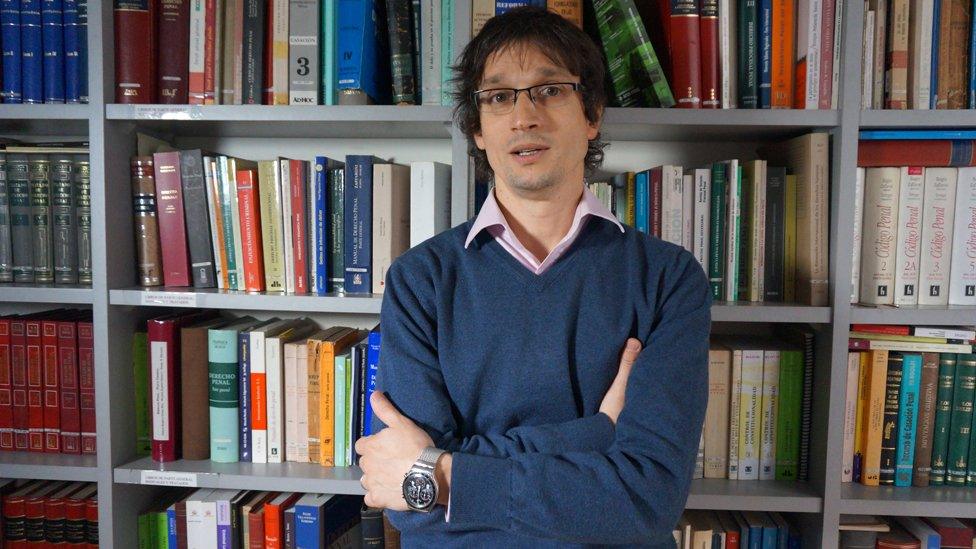
Diego Lagomarsino
"I didn't have an option. Alberto was a hard man to say no to," he said.
Lagomarsino says he took the gun to Nisman's apartment on the evening of 17 January, a Saturday, and then left. He agrees he may have been the last person to see the prosecutor alive before he died around midday on the Sunday, as the official autopsy concludes.
But Sandra Arroyo Salgado says Lagomarsino has more explaining to do after her investigators concluded Nisman died much earlier, on the Saturday night.
Nisman had been speaking almost non-stop on the phone to journalists and politicians in the days leading up to his potentially explosive testimony to Congress - which was due to happen on the Monday - but on Saturday evening this normally active man fell silent. A Sunday newspaper outside his flat lay untouched. Why?
"I believe the time of death must have been when he stopped making calls, because he was someone who was constantly on the phone," says Arroyo Salgado.
"It's inconceivable, inconceivable, that he wouldn't have made a single call for so many hours. The first thing he did in the morning, during all the time I knew him, was get the newspaper and read it and that's exactly what he would have done at a time when he was so much in the news himself."
Those doubts about whether the case is being handled impartially and independently, are felt throughout Argentine society.
Exactly one month after Nisman's body was found, hundreds of thousands marched in torrential rain across Buenos Aires, protesting against impunity - the feeling that, yet again, another high profile crime would inevitably go unsolved because of judicial incompetence and political interference.
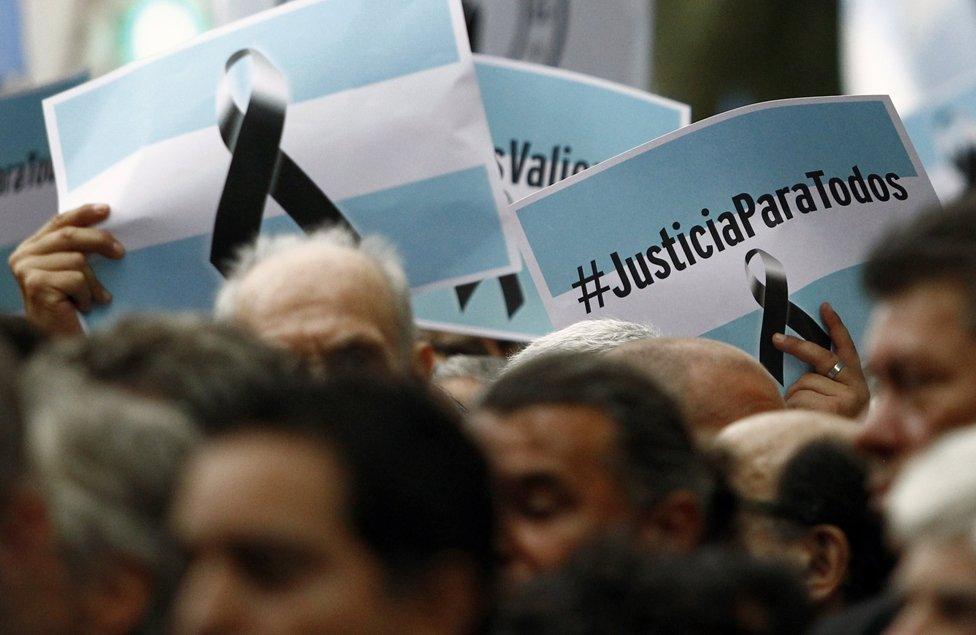
The sign reads "Justice for everyone" Photo: AFP
Cristina Fernandez de Kirchner is having none of it.
Argentina's combative president has repeatedly derided the protestors and her critics. Suggesting that someone perhaps got to Nisman as a way to undermine her government, the president has criticised the former prosecutor and his report.
The tension between them dates back at least to January 2013 when Argentina signed a deal with Iran, establishing a "truth commission" ostensibly to jointly investigate the Amia bombing. Nisman, who had spent 17 years working on the case and had brought formal charges against several senior Iranian figures in 2006, couldn't contain his anger.
On radio and television he accused President Fernandez de Kirchner and Foreign Minister Hector Timerman of acting unconstitutionally and illegally interfering in the judicial process.
Nisman later elaborated, saying that the government was trying to reach a deal with Tehran to enhance bilateral trade and benefit Argentina's troubled economy.
Foreign Minister Timerman, who like Nisman is Jewish, told me it was inconceivable that he, of all people, would betray the memories of those who died in the Amia bombing and said Nisman's allegations against him and the president were baseless.
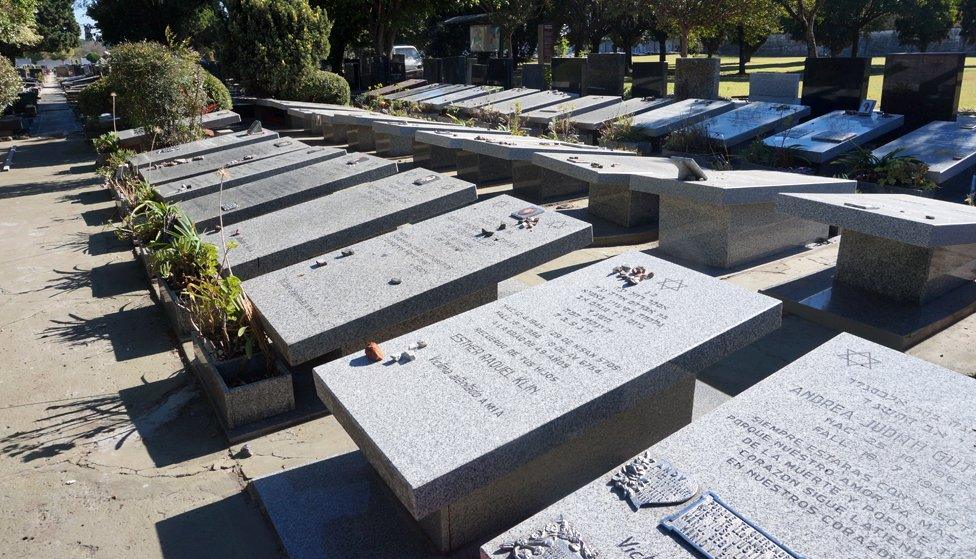
Graves of people who died in the Amia bomb
"I know that he drafted an order of arrest against myself and I will defend myself in court. I only trust in the law, I will go to court, " Timerman told me, clearly dismissive of Nisman's report which he describes as a legally flawed document.
Timerman adds, "We did more than any other government in order to find out who committed the terrible crime against the [Amia] Jewish centre, more than any other government."
It's known, from documents released by Wikileaks, that Nisman was a regular visitor to the US embassy in Buenos Aires. He saw secret intelligence briefings that probably influenced his investigation into the Amia bombing. He's also believed to have had close links with the Israeli Mossad.
After Nisman died, Hector Timerman sent open letters to Washington and Israel, warning them to back off Argentina's internal affairs.
"I think that there are countries whose intelligence services operate in third countries without the authorisation of those countries," says the foreign minister. "What I am saying in my letter is just telling them that if they are doing that they should stop."
I pushed him further, asking if he sent those "warning" letters because of what has been learned from the Nisman case.
"We don't send letters without evidence," he replied brusquely.
What is not in doubt is the role played by Argentina's internal intelligence agency in Alberto Nisman's life and, say some, in his death too.
For decades the operations director at SI, as the agency was known, was Antonio "Jaime" Stiuso, a man so elusive only one known image of him exists.
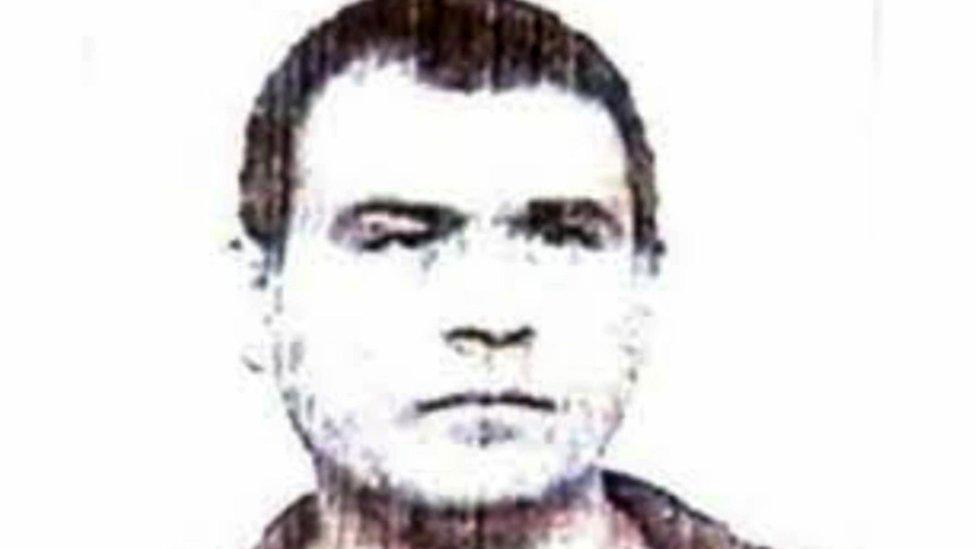
He worked closely with Nisman on the Amia case, feeding him wiretaps and other sensitive information.
Stiuso, like Nisman, eventually fell foul of the government over their opposition to the controversial deal with Iran and when splits developed inside the SI Stiuso was sacked. He is now on the run, believed to have fled the country.
Perhaps Alberto Nisman paid an even higher price for taking sides in a dangerous game.
Argentine Judge and international war crimes prosecutor, Luis Moreno Ocampo has taken a keen interest in the story. He says that in a hangover from Argentina's dark years of dictatorship, spies still wield enormous power over the judicial system, of which Nisman was a part.
"In the 70s and 80s, our intelligence system was part of the massive atrocities committed by the dictatorship. This is over. It has stopped," insists Moreno Ocampo.
"But the Nisman case exposed that democratic governments did not change the functioning of the intelligence system. They're no longer committing massive atrocities but they manage money for political purposes, spy on opposition members, control judges and prosecutors that want to investigate the government. So that's what we have here. And Nisman's case exposed that."
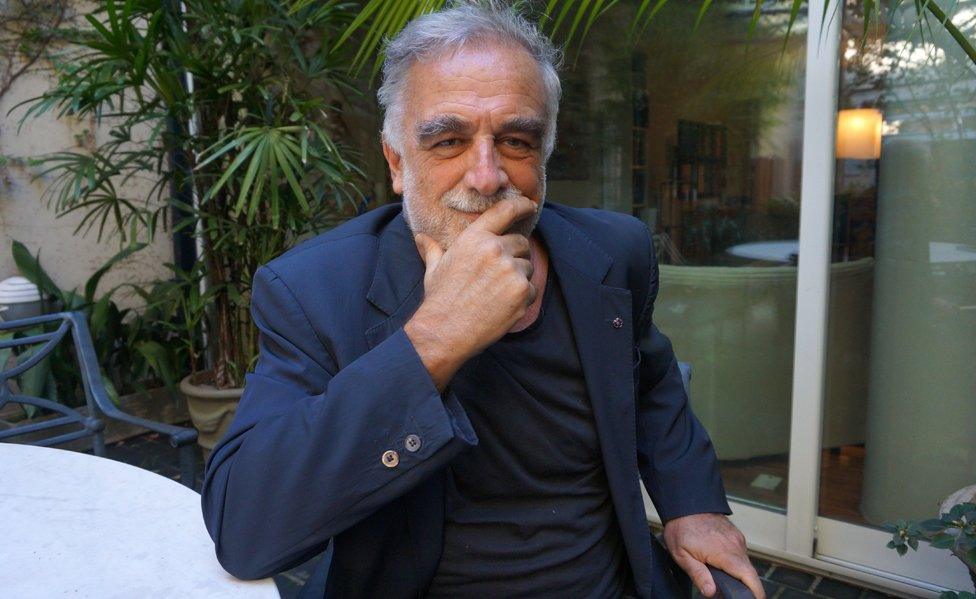
Luis Moreno Ocampo
In a city full of secrets and suspicions, the one person who really got close to Nisman and, he says, gave him the gun was the IT specialist Diego Lagomarsino. But some believe he was also an intelligence agent. Did he, as has been alleged, even have a role in Nisman's death?
"No," Lagomarsino told me emphatically. His job was merely to look after the prosecutor's computer needs.
"I have truth on my side, I know that I didn't do it and this saves me. God knows I didn't do it. I know I didn't do it. And it will be proven," protests the former aide, his voice becoming emotional.
"When all this is over, they will ask for my forgiveness. And I will give it to them."
This apparent political murder has gripped Argentina but in a vital election year the Argentine government seems anxious to wrap up the case quickly and put it to rest.
Government insiders have gone to some lengths to sully the prosecutor's character, accusing him of being a womaniser and of even misappropriating funds from his office. Pictures of him partying with younger women, apparently taken from his mobile phone, have been leaked to the media.
Meanwhile Nisman's investigation into the alleged Amia cover-up has officially been shelved.

There are half a million files and audio tapes relating to the Amia bombing


Escuchas is Spanish for wiretaps
Sandra Arroyo Salgado recounted to me a conversation between Nisman and their eldest daughter just days before his death, in which he emphasised the significance he attached to his report.
"He told her, I have been working for some time on something very important. You're going to be so proud of my work," says Arroyo Salgado, repeating the conversation between father and daughter. "But sometimes in life we don't choose the moments that things happen, and I have to present this report now, it's a big project that I've been working on for a long time and there's a risk that if I don't do it now, it's possible I will never be able to show this to Congress, and that I will lose my job."
Alberto Nisman never got to the Argentine Congress to deliver that controversial report. It was discredited by some but those who knew Nisman say he was convinced he was getting close to the truth and was certainly not suicidal.
Who was responsible for the Amia bombing 21 years ago, whether there was a cover-up and who killed Alberto Nisman may now never been known.

Who Killed Alberto Nisman? will be broadcast on Our World on BBC World TV at 00:30 BST on Saturday 30 May. It will be on the BBC News Channel at 21:30 BST on Saturday 30 and Sunday 31 May.
Subscribe to the BBC News Magazine's email newsletter, external to get articles sent to your inbox.